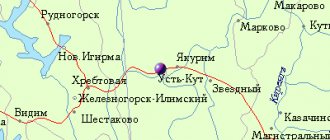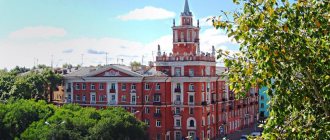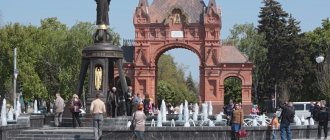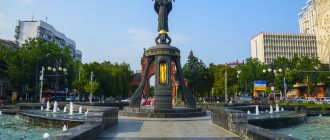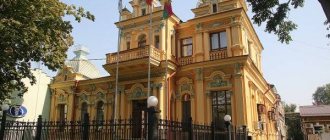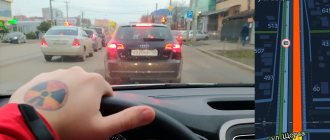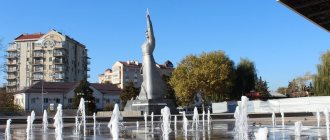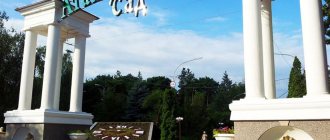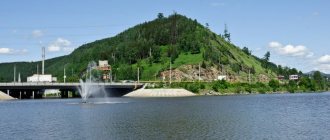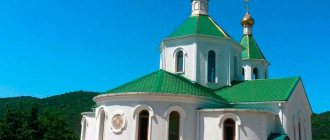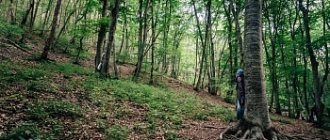Krasnaya is the main street of Krasnodar, where the administrative, business, cultural and social life of the Kuban capital is concentrated. The main city events are held here, and acquaintance with Krasnodar and its attractions begins from here.
The highway runs along the border of the Western and Central intracity districts: one road from the street. Guard north to the street. named after Budyonny, and then into two roads separated by a wide boulevard to the street. named after Gavrilov P.M. and st. Officer's. The length of the street is about 5.05 kilometers.
History, renaming
Red Street has existed almost since the very foundation of Krasnodar (then and until 1920 - Yekaterinodar), but it received its name later. The first written mention of the name appears in a document from 1835. The word “red” means beautiful, best, honorable, ceremonial. Some local historians also associate the name with long shopping rows made of baked red bricks that were once located along the road.
The main street has undergone several name changes. From 1914, after the visit of Russian Emperor Nicholas II (1868-1918) to Krasnodar, and until the 1917 revolution, Krasnaya was Nikolaevsky Avenue. Then, for some time, it became Rostov and named after Shevchenko - in honor of the Ukrainian poet Taras Grigorievich Shevchenko (1814-1861). During the German occupation of Krasnodar (1942-1943) during the Great Patriotic War, the invaders called the Adolf-Hitler Strasse highway in honor of the head of Nazi Germany, Adolf Hitler (1889-1845). From 1949 to 1957, the street bore the name of Stalin in honor of the statesman and military figure, head of the USSR (1924-1953) Joseph Vissarionovich Stalin (1878-1953). On April 22, 1957, the final return of the historical name took place.
Video: Walk around Krasnodar - Krasnaya Street
- Similar articles:
- Goryachy Klyuch, Krasnodar region
- Skala Kiseleva, Tuapse
- Novorossiysk - embankment, attractions
- Lake Abrau, attractions of Abrau-Durso
- Abrau-Durso - tour of the champagne factory
- Gelendzhik 2016: Gelendzhik embankment
- Rock Parus, Praskoveevka village, Gelendzhik
- Pshad waterfalls and dolmens in the valley of the Pshada River
- Zhane waterfalls, dolmens, Vozrozhdenie village, Gelendzhik
- Old Kabardinka park, embankment
- Safari Park Gelendzhik
What to see: buildings and attractions
Power
- Legislative Assembly of the Krasnodar Territory (3)
- Krasnodar Regional Court (10)
- Administration of the Krasnodar Territory (35)
- Administration and City Duma of Krasnodar (122)
Legislative Assembly
Culture (theatres, halls, museums)
- Central Concert Hall of the Kuban Cossack Choir (5)
- Krasnodar Regional Art Museum named after. F. Kovalenko (13, 15)
- Musical theater TO "Premiere" named after. L.G. Gatova (44)
- Krasnodar Regional Exhibition Hall of Fine Arts (at 29)
- Krasnodar Regional Puppet Theater (31)
- State Historical and Archaeological Museum-Reserve named after. E.D. Felitsyn (at 58)
- Krasnodar Philharmonic named after. G.F. Ponomarenko (55)
- Municipal Concert Hall for Organ and Chamber Music (122)
- Krasnodar Academic Drama Theater named after. M. Gorky (at 122)
- Aurora Cinema (169)
Central Concert Hall
Libraries
- Krasnodar Regional Universal Scientific Library named after. A.S. Pushkin (8)
- Krasnodar Regional Children's Library named after. Ignatov brothers (26/1)
- Central City Library named after. ON THE. Nekrasova (87)
- Krasnodar Regional Youth Library named after. I.F. Barabbas (Red/Officer)
Scientific Library named after A.S. Pushkin
Education
- Kuban State Technological University (91, 135, 166)
Medicine (hospitals)
- Specialized Clinical Psychiatric Hospital No. 1 (1)
- City Clinical Hospital No. 1 (103)
Hotels
- Hilton Garden Inn (25/2)
- Moscow (60)
- Marriott (120)
- Crowne Plaza Krasnodar (109)
- Caucasus (174)
- Dynamo (190)
Hilton Garden Inn
Marriott Hotel
Shopping centers, shops
- Shopping center House of Books (43)
- Shopping center Arbat (81)
- Shopping center Gallery (between 113 and 127, Krasnaya/Severnaya)
- TC City Center (176)
- Department store Krasnodar (157)
Shopping center Gallery
Hypermarkets, markets
- Magnet Family (Shopping Center Gallery)
- Crossroads (176)
- Tabris (202)
- Weekend fairs
Temples
- Military Cathedral of the Holy Blessed Prince Alexander Nevsky (district 3)
- Temple-chapel of Alexander Nevsky (opposite 35)
- Temple of the Icon of the Mother of God Joy of All Who Sorrow (103)
Military Cathedral of Alexander Nevsky
Monuments
- Stone at the site of the founding of Krasnodar in 1793 (3)
- Bust of Prince Alexander Nevsky (3)
- Cross in honor of the creators of the Slavic alphabet Cyril and Methodius (3)
- Monument to the Empress and founder of Krasnodar Catherine II (3)
- Monument to the poet A.S. Pushkin (8)
- Bust of the artist I.E. Repina (15)
- Sculpture Dog's capital (25)
- Monument to the Kuban Cossacks (35)
- Bust of Marshal G.K. Zhukova (35)
- Memorial arch Kuban is proud of them (35)
- Monument to composer G.F. Ponomarenko (55)
- Sculpture Zaporozhye Cossacks writing a letter to the Turkish Sultan (96)
- Obelisk in honor of the 200th anniversary of the Kuban Cossack army (109, 124)
- Sculpture Guest (127/1)
- Monument to the Soldier (135)
- Sculpture Students (Shurik and Lida from L.I. Gaidai’s comedy “Operation “Y”) (135, 172)
- Monument to scientist M.V. Lomonosov (135)
- Monument to the Holy Great Martyr Catherine (143, 176)
- Triumphal Arch for Emperor Alexander III (Royal Gate) (145, 178)
- Monument to the Cossacks and Highlanders, heroes of the First World War (198)
- Aurora Statue (169)
Monument to the Holy Great Martyr Catherine
Triumphal Arch (Royal Gate)
Recreation
- Catherine Square (3)
- Square named after G.K. Zhukova (35)
- Aleksandrovsky Boulevard (from Budenny Street to Ofitserskaya Street)
- Dynamo Stadium (190)
- Flower clock (167)
- Fountains (the largest dry light and musical fountain is at 122, Main City Square)
Catherine Square
Flower clock
The main attractions of Krasnaya
The main attractions of Krasnodar are concentrated on Krasnaya Street, so there is no question of what to see when walking along it just for the sake of it. It is best and most convenient to do this on weekends or on holidays, when its section from Sovetskaya and up to Teatralnaya Square is closed to any motor transport, making it convenient for walking.
All this makes it possible to go on a kind of mini-tour of objects with children - devoid of motor traffic, the promenade becomes much safer, allowing you to concentrate on the inspection.
In order to get maximum pleasure from the walk, you should walk the street from beginning to end - from the side of the Maxim Gorky Park, located near the center, to the Pervomaiskaya Grove. This path is quite long, but it will be extremely exciting and educational, and the energy expended will more than pay off due to the impressions gained.
Alexander Nevsky Church
Initially on the route you will encounter the Alexander Nevsky Temple, or Nevsky Lavra, as it is also called, the largest and most revered religious building in the city. The white stone walls of the cathedral were erected in 1872 by talented Russian architects, the Chernik brothers. From the moment of its appearance, it acted as a unique symbol and personification of the Kuban Cossack detachment. This circumstance determined its fate in the future - the Bolsheviks, impatient with religion in general and the Cossacks in particular, blew up the church in 1932, destroying it to the ground.
In 2003, following numerous appeals from citizens, the governor of the Krasnodar Territory, Alexander Tkachev, decided to restore the Nevsky Lavra. Although the destroyed temple had to be rebuilt from scratch, using old photos of the shrine, it was rebuilt in record time - already in 2006, Patriarch Alexy II consecrated the newly built cathedral. It became the largest in the entire region, occupying an area of almost 1500 square meters. m, reaches a height of 52 m, can accommodate more than half a thousand people at a time. Truly amazing numbers.
Monument to Catherine II
It is listed among the most interesting in Krasnodar; Krasnaya Street represents it next on the route. The statue was installed in the greenery of Catherine Square and remains especially revered by the townspeople, although it is a modern reproduction.
Its creation and installation were timed to coincide with the 100th anniversary of the resettlement of the Black Sea Cossack army to the Kuban region in 1806. The ceremonial laying took place in 1896, and academician Mikhail Mikeshin was involved in the execution of the sculpture, but his unexpected death almost buried the project along with him, however One of Mikhail Osipovich’s students, Boris Edwards, took up the work and completed the creation in 1907.
It immediately turned into a business card of Ekaterinodar, but already in 1920 it repeated the fate of the temple described above - by decision of the Kuban Cheka, the monument to Catherine the Great was removed, and in 1931 it was melted down. Its restoration began in 2002, it was supervised by the Honored Artist of the Russian Federation Apollonov, who completed the work in September 2006.
Walking Dogs Monument
We are talking about the next, very funny attraction - a small bronze sculpture made in a caricature. It was born thanks to the famous statement about Krasnodar by Vladimir Mayakovsky, who called the city “the dog capital”, and it was performed by the famous Soviet sculptor Valery Pchelin in the early 30s. last century.
It was installed at the intersection of Krasnaya and Mira streets, near a beautiful building with a clock and a high spire, built in the Baroque style. A local legend says: if you rub a dog’s paws and make a wish, it will definitely come true, but apparently not many have their dreams and wishes come true - the dogs’ noses are rubbed to shine, not their paws. Just like that.
“Kuban is proud of them”
The memorial, presented in the form of a high arch with colonnades on the sides, topped with a sculptural image of the Holy Great Martyr George the Victorious, is a real symbol of Krasnodar, without being a monument. An arch was installed at the entrance to the park named after Georgy Konstantinovich Zhukov, one of the green city oases.
It was timed to coincide with the 50th anniversary of the victory in the Second World War, dedicating it to the memory of the heroes of the Krasnodar region who fell for their homeland. Construction began in 1995 - on the site of the Kuban Military Cathedral destroyed by the Bolsheviks, and at the end of 1996 the first stage of the memorial was opened, completed and opened in a solemn ceremony on Victory Day 1997.
Kuban Cossacks
The revived historical monument, located on Krasnaya Street, is expressed by a tall obelisk. The latter was installed at this place at the end of the 19th century, it was dedicated to the Khoper regiment, in 1696 as part of the Russian army led by Peter the Great, who showed miracles of courage during the storming of Azov.
The creation of the monument was carried out by the most famous of the regional architects, Vasily Filippov, who completed it in a few months, by the end of 1896. Like other memorial signs of tsarist times, it was destroyed after the October Revolution. At the time of the celebration of the 200th anniversary of the Cossack army of Kuban in Krasnodar, they decided to revive the destroyed obelisk, dedicating it to this memorable date. The restoration was carried out by Alexander Apollonov, who completed the work in the fall of 1998.
Crossroads
St.
Red crosses 26 streets: Postovaya st. (beginning) ➜ Pushkina st. ➜ Sovetskaya st. ➜ Komsomolskaya st. ➜ Mira st. ➜ Ordzhonikidze st. ➜ Lenin st. ➜ Gimnazicheskaya st. ➜ Gogol st. ➜ Karasunskaya st. ➜ Chapaeva st. ➜ Maxim Gorky st. ➜ Pashkovskaya st. ➜ Long street ➜ Budyonny st. ➜ Kalinina st. ➜ Kuznechnaya st. ➜ Volodya Golovatogo st. ➜ North st. ➜ Hakurate st. ➜ Babushkina st. ➜ Odesskaya st. ➜ Neftyanikov Highway st. ➜ Gavrilova P.M. st. (end 1) ➜ Kurganny lane. ➜ Ofitserskaya st. (end 2) Streets and houses of Krasnodar 5000+ apartment buildings
Historical reference
Krasnodarskaya Street received the name “Red” from the very foundation of the city, and not at all from Soviet times, as one might think. This word used to mean “beautiful,” which fully corresponds to this Kuban corner. Indeed, Krasnaya is the most beautiful street in the Kuban capital.
It is on Krasnaya that the mixture of many architectural styles is clearly visible - pre-revolutionary, Soviet era with its Stalinist and Brezhnev houses, as well as buildings of the post-Soviet era.
There are also new buildings on Krasnaya, built by analogy with the old destroyed architectural monuments.
Street of contrasts
No less cozy and spacious is Pushkinskaya Square, the buildings on which create an interesting contrast - the ultra-modern Arbitration Court and the Krasnodar Regional Library named after A.S. - a building with a history that is more than a century old; in front of the entrance there is a thoughtful and dreamy monument to the Great Poet Pushkin. Poetry lovers gather here to read famous works, or their own poems for the surrounding public.
Opposite, in two buildings, is the Kovalenko Regional Art Museum. This amazing man worked for a very long time to ensure that the city had its own art museum, despite the delays of officials, he succeeded. A chic mansion built in 1905, pale blue in color, houses a museum, and pleases the eye with its well-groomed and elegant antiquity.
Art Museum named after. Kovalenko
Further on, Krasnaya Street becomes quite narrow, lush trees create wonderful shade on hot days, and numerous cafes, restaurants, trendy coffee shops, bright bars, from where the smell of coffee emanates, mixed with the sweet aroma of baked goods, create the mood of an eternal weekend.
Monument to Catherine II and a little history
We go to the legislative assembly:
Opposite it is a small park and a majestic monument to Catherine II . In the center of the pedestal is the text of the Charter dated June 30, 1792. On the left, Prince Potemkin-Tavrichesky is depicted against the background of battle banners and military insignia. On the right are the first three atamans of the Black Sea Cossack army: Zakhary Chepega, Sidor Bely and Anton Golovaty. On the back side of the monument there is a picture of a blind kobzar with a guide, and there is also a list of victories won by Russia with the participation of the Kuban Cossacks.
Monument to Catherine II
Monument to Catherine II
This monument reflects the history of the founding of Krasnodar . On June 30, 1792, Catherine II issued a Charter to the Black Sea Cossack Army, according to which this land was transferred to the local Cossacks. And in 1793 they founded the city of Ekaterinodar here, reflecting the essence of its appearance in the name. Initially there was a military camp here, then a fortress. And since 1860, Ekaterinodar became the center of the formed Kuban province. Received city status in 1867. Renamed Krasnodar in 1920. At the moment, the city's population is about 850 thousand people.
This is where Krasnaya Street ends and the main attractions too. Then you can stroll along the neighboring streets, look at the historical part of the city and even find your lost wallet . True, it is too heavy to lift, apparently there is too much money lying there)))
Try it, steal it))
In the next part we will walk along the embankment of the Kuban River, visit Victory Park and Sunny Island, and I will also share the main impressions of visiting the city of Krasnodar.
Map:
0
History of street names in Krasnodar
Memorable places, buildings, memorial plaques on the streets of Krasnodar can tell an extraordinary amount about its history. And every day, when we travel in public transport, walk along the sidewalks, the “headings” of individual chapters of the city’s chronicle flash before us—the names of the streets. Some of them are familiar to us from childhood, while others sometimes make us wonder how and why the street got this or that name, and what it was called before. Since the early 90s, many streets in Krasnodar have been renamed. They were given back their old, ancient names, which are not always clear and cause confusion and a lot of questions. To answer them, it is necessary to turn to the history of the founding of the city of Ekaterinodar and its first settlers.
In the spring of 1793, the Cossacks built a fortress in the southern part of the Karasun Kut. And it was from here that they cut a wide clearing in the forest and drew the first furrow with a plow - the current street. Red. The Black Sea region at that time was subordinate to the Tauride governor in terms of civil affairs, and he approved the development plan for Yekaterinodar. The main principle of the layout was the straightness of the streets, oriented almost exactly from south to north and from west to east. The streets intersected at right angles and were clearly visible, which met the objectives of defense. The blocks, for the most part, had a square shape and were the same in size. This is how ancient and medieval cities were built.
To implement the approved plan, a land surveyor was sent to Ekaterinodar from Simferopol to carry out land surveying. However, the settlers did not wait until they were allocated a plot for construction, and had already built houses for themselves in the places that they liked. It turned out that many buildings are located directly on future streets, i.e. in the middle of the roads and with very different orientations in relation to the street: sideways, corners, facades. It was impossible to change anything, as people were exhausted from moving and settling into a new place. The governor, however, was informed that the demarcation had been made. In the end, a few years later, the houses blocking the streets were demolished, and if we look at one of the early plans of the city, we will see how smooth and strictly parallel the streets of old Yekaterinodar are.
The main street was almost the axis of symmetry of the urban area. The parallel streets closest to it were considered central, while the transverse ones were initially called alleys, had a smaller width compared to them, and even that changed at the will of its inhabitants.
The buildings in the city at that time were mostly turkish. There was not a single stone or two-story house. Nevertheless, Ekaterinodar had a completely original appearance. “ The blocks between the streets are filled with dense forest - not gardens, but a forest that consists of mighty leafy oaks..., large white acacia trees and a thicket of fruit trees. When you walk down the street... the impression is exactly the same, as if you are in a clearing in a dense forest, along the outskirts of which dachas or rural houses are built
". This is what St. Petersburg resident N.N. wrote. Filippov in the book “A Trip along the Shores of the Sea of Azov..”, published in St. Petersburg in 1857. If we add to this the terrible lack of amenities, then it is not difficult to imagine what our city was like in the first 50 years of its existence. The streets, lacking sewerage facilities, turned into swamps in bad weather. To avoid losing their own boots in the mud, residents were forced to tie them up with ropes. Often there was a stuck cart right in the middle of the street, and they could not close their own shutters except on horseback. They fought the mud with the help of ditches dug along the streets and discharging water into Kuban and Karasun; wooden bridges were thrown over them at intersections. Over time, wooden sidewalks were built that resembled pile buildings. All this gave the city a special flavor.
It is surprising that the street names did not appear immediately, and they are not yet on the plan. Apparently there was no time for that. How, then, did they find the right address? It wasn't that difficult. They used landmarks: “on the second street from the main street”, “not far from the bazaar”, “above Karasun”, “above Kuban”, etc.
The names were finally formed by the 70s of the XIX century. And it’s good that the city’s founders were in no hurry: there were no random names. A short but succinct word necessarily carried some information: it explained either the origin of the street, or its purpose, or what was on it, who lived, etc. Over time, many streets changed their names, more than once.
For example, Red
changed its name 4 times. Built up with one-story houses, shops, huts, often with thatched or reed roofs, in the first half of the 19th century. it was not much different from the other streets. However, even then it was perceived as the main thoroughfare, an avenue. The word “red” was often used in Russian to mean beautiful, best, ceremonial. This meaning is apparently embedded in the name of the street. Perhaps it was the best in the city, as far as beauty is concerned... In the 1850s, a historian wrote: “With the avenue leading to the Cathedral Church, a street called “Red” runs through the entire city. Never has an epithet been placed so poorly.”
In 1914, in honor of the arrival of Nicholas II in Ekaterinodar, it was renamed Nikolaevsky Prospekt, but in 1917 the previous name returned. It also changed during Soviet times. In 1949, when the 70th anniversary of I.V. was celebrated. Stalin, the street was named after him. And finally, in 1957, its first name was returned to it for the second time.
In the south, the border of Krasnaya for a long time was the street. Pushkin
. She walked along a huge square, spread out in front of the Cossack fortress in the southern part of the Karasun Kut. This proximity to the fortification structure determined the name of both the square and the street - Krepostnaya.
st. Krasnoarmeyskaya
was originally known as Bursakovskaya. At one time, the estate of the military ataman of the Black Sea Cossack army, Major General Fyodor Yakovlevich Bursak, was the largest on the street, and was, as it were, its “calling card”.
Opposite the art museum, on the same side of the street. Red, there was a large one-story house. From 1863 to 1869, the owner of the residence was Count Felix Nikolaevich Sumarokov - Elston. He did a lot for the development of Ekaterinodar as a civil city. He took care of the improvement of city streets, promoted the opening of new educational institutions, and encouraged Ekaterinodar residents to build good houses. The count's tenure as head of the Kuban region and ataman, as well as the location of his household, apparently determined the first name of the street. Soviet
- Count's.
St. Oktyabrskaya
once appeared on city maps as Pospolitakinskaya.
To the artist E.I. Pospolitaki belonged to house No. 24 on the street. Red. In November 1898, he opened “painting and drawing classes” here, which laid the foundation for art education in Yekaterinodar. Tuition was paid, and poor but capable students were taught free of charge. In a word, he was a famous man. However, the name of the street most likely relates to another Pospolitak military foreman (a relative of the artist) who owned retail premises, the so-called “Pospolitak rows” along Krasnaya and Ekaterininskaya (now Mira
).
The most long-suffering street in terms of renaming is Gimnazicheskaya Street. In the area of the Administration building, a theater was once a notable object, opened on the initiative of the ataman N.A. Ivanov, who headed the Kuban region from 1861 to 1863. The street adjacent to this block was initially called Teatralnaya. The theater existed for more than 12 years. But in 1873, a men's military gymnasium was built here. At the same time the street was renamed Gimnazicheskaya
. Over the subsequent more than century-long history, she had the opportunity to visit Rabfakovskaya (1929), Hakurata (1936), Yezhov (1937), again Rabfakovskaya (1938), Voroshilov (1939), Communist (1957). ), again Voroshilov (1970), and, finally, from 1993 - Gymnasium.
Running parallel to Red Street. Rashpilevskaya
received its name after the chief of military headquarters, performing the position of ataman, Lieutenant General Grigory Antonovich Rasp. Seeing that the military foreman was taking the best lands for “eternal and hereditary use,” he insisted on land surveying to distribute plots in accordance with the norms (they were different for different ranks) among residents who belonged to the Cossack class.
The street now known as Sedina
, until 1920 bore the name of the military ataman of the Black Sea Cossack army, Major General Timofey Terentyevich Kotlyarevsky.
In the first decades of Ekaterinodar’s existence, along modern street. Long
passed the northern defensive rampart.
At the intersection of the shaft with the street. The Red Gate was the Main Gate. Here the city ended. Immediately behind the rampart began the city cemetery, where one of the first city churches was built - the Church of St. Thomas. When hostilities related to the Caucasian War ended, there was no longer a need to cover the city from the north. The rampart was demolished, the ditch that ran along it was filled up, and in this place a street was laid, called Long, since it was indeed longer than all the other transverse streets. And the city, and along with it the longitudinal streets, grew northward by one block. A new street was built parallel to Dlinnaya, and it was named Novaya (now Budyonny
).
When new blocks were laid out for development in the northern part of the city, the streets parallel to Krasnaya were extended, preserving the name of the old street in the new part. The exception was the main street of the city. Forges stretched along it, a little to the east - lumber factories, on both sides - warehouses for various equipment, tobacco warehouses, etc. The very meaning of the name (beautiful, best) did not fit this suburban stretch. Apparently that's why they gave it a different name. In Russia, it was very common to give the streets that arose on the site of roads the names of the localities where these roads lead. So in this case the street was called Rostovskaya
, along the road to the city of Rostov-on-Don that passed here.
With the beginning of the construction of Rostovskaya Street, timber exchanges and numerous blacksmith shops were transferred to the line of the street, named, accordingly, Kuznechnaya
.
Outside the street Rostovskaya, where Krasnaya was laid after the war, began in the past as urban pasture land. The last cross street was Stepnaya
, and the name shows that the steppe began further. Subsequently, it was called Vygonnaya, Peasant, and in 1967 it received the name by which it is known now - in honor of the first chairman of the Adygea Regional Executive Committee Sh.U. Hakurate.
Policewoman (now - Gogol
), Bazarnaya (
Ordzhonikidze
), Sobornaya (
Lenin
), Yarmarochnaya (
V. Golovatogo
) - all these streets were named after those important institutions and objects in the life of the city that were located on them. St. The police began to be called Gogolevskaya in 1902, when the 50th anniversary of the writer’s death was celebrated.
Analyzing all this information, it is not difficult to understand on what grounds the streets were assigned this or that name. There are not so many of them:
1
) For large households of persons known in the army (Bursakovskaya, Borzikovskaya, etc.); the most central streets were named precisely on this basis, not so much in honor of a given person, but in honor of his household, which was noticeable and was taken as the main distinguishing feature of the street;
2
) On roads leading from the city to other settlements (Plastunovskaya, Dinskaya, Medvedovskaya, etc.)
3
) For a significant object on the street (square) or near it (Gimnazicheskaya, Sobornaya, Bazarnaya, etc.)
4) By location, origin, purpose of the street (Podgorny Lane, Nasypnaya, Progonnaya, Skvoznaya, etc.).
And the next time a familiar name flashes on the sign, the image of old Yekaterinodar will involuntarily emerge, with its noisy shops, wooden churches, one-story houses and pavements. And once again you will be convinced that street names are no less important historical monuments than architectural structures, objects stored in museums, or eyewitness accounts of that time that have reached us.
